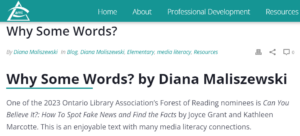For today’s tech-savvy kids, here’s the go-to resource for navigating what they read online.
Should we believe everything we read online? Definitely not! And this book will tell you why. This fascinating book explores in depth how real journalism is made, what “fake news” is and, most importantly, how to spot the difference. It’s chock-full of practical advice, thought-provoking examples and tons of relevant information on subjects that range from bylines and credible sources to influencers and clickbait. It gives readers context they can use, such as how bias can creep into news reporting, why celebrity posts may not be truthful and why they should be suspicious of anything that makes them feel super smart.
Young people get most of their information online. This must-read guide helps them decide which information they can trust—and which they can’t. Author and journalist Joyce Grant is an expert on how young people interact with and think about online media. Never judgmental, and often hilarious, she encourages readers to approach what they find online with skepticism and helps them hone their critical thinking skills to make good choices about what to believe and share. Engaging text is broken into manageable chunks, with loads of Kathleen Marcotte’s playful illustrations on every spread to help explain tricky concepts. Two fake articles are deconstructed step by step using the information found in the book, and an additional article allows readers to test their skills. This comprehensive book has strong curriculum connections in language arts and social studies.
End matter features a glossary, an author’s note, sources and an index.
Published by Kids Can Press, Toronto, Ontario. June 7, 2022
Illustrated by Kathleen Marcotte. Edited by Kathleen Keenan and Designed by Andrew Dupuis.
- June 7, 2022
- Hardcover: 56 pages
- ISBN-10: 1525303228
- ISBN-13: 978-1525303227
- List Price: USD $18.99, CAD $19.99
- 4-color 9 x 10 56 pages
- Grades: 4 To 7, Ages: 9 to 12
AWARDS
- 2023 – Hamilton Literary Award (Children’s Book), Hamilton Arts Council, Winner
- 2023 – Hamilton Literary Award (Non-Fiction), Hamilton Arts Council, Winner
- 2023 – Press Freedom Teaching Award; Educator, Global Youth & News Media, Winner (Gold)
- 2023 – Yellow Cedar Award, Ontario Library Association, Nominee
- 2023 – 2023-24 Hackmatack Children’s Choice Book Award, Hackmatack, Short-Listed


![]()

REVIEWS
“A valuable—and entertaining—guide to an important subject.”
— Kirkus Reviews, 13 April, 2022
“This is an excellent introduction to media literacy for young readers who are bombarded with information daily.”
— Youth Services Book Review, starred review, 29 April, 2022
“… a worthwhile addition to libraries and media literacy curriculum.”
— Canadian Children’s Book News, 05 August, 2022
“… this book can be used by readers from all ages and is an excellent resource for learning about fake news and how to identify it.”
— CM Magazine, 30 September, 2022
















